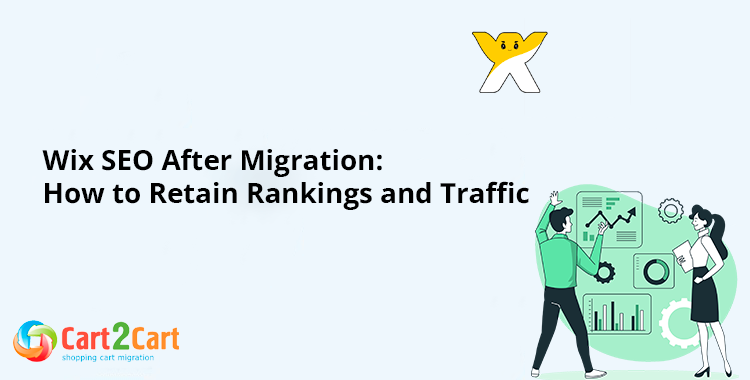 Migrating from Wix to Shopify can be a game-changer for your online business. However, if not handled correctly, the transition can lead to a drop in search engine rankings and traffic losses. SEO plays a crucial role in maintaining visibility and ensuring customers continue to find your store. In this article, we’ll explore the key strategies to retain your rankings and traffic after a Wix to Shopify migration.
Migrating from Wix to Shopify can be a game-changer for your online business. However, if not handled correctly, the transition can lead to a drop in search engine rankings and traffic losses. SEO plays a crucial role in maintaining visibility and ensuring customers continue to find your store. In this article, we’ll explore the key strategies to retain your rankings and traffic after a Wix to Shopify migration.
Perform a Full SEO Audit Before Migration
Before you begin the migration process, conduct an in-depth SEO audit of your Wix store. Identify key pages that drive the most traffic and note important elements such as:- High-ranking keywords
- Meta titles and descriptions
- URL structures
- Image alt texts
- Internal and external backlinks
Maintain URL Structure or Set Up Proper Redirects
One of the most common SEO issues after migration is broken links due to URL changes. Wix and Shopify have different URL structures, so it's crucial to:- Keep the same URL structure whenever possible.
- Set up 301 redirects for all changed URLs using Shopify’s built-in redirection tool.
- Monitor Google Search Console for any crawl errors and fix broken links promptly.
Optimize Shopify’s SEO Settings
Unlike Wix, Shopify provides more flexibility for SEO optimization. After migrating, ensure you optimize the following Shopify SEO settings:- Meta titles and descriptions: Retain or improve them based on keyword research.
- Image optimization: Use descriptive file names and add alt text for better image SEO.
- Product and collection pages: Ensure keyword-rich content and structured URLs.
- Schema markup: Use Shopify SEO apps to add structured data and enhance visibility in search results.
Submit Your New Sitemap to Google
After migration, update Google with your new Shopify store structure by submitting your sitemap to Google Search Console. Here’s how:- Log into Google Search Console.
- Navigate to the “Sitemaps” section.
- Enter your Shopify sitemap URL (e.g., yourdomain.com/sitemap.xml).
- Click “Submit” and monitor for any crawl issues.
Preserve and Improve Site Speed
Site speed affects both user experience and SEO rankings. Wix websites can sometimes be slower due to built-in site structures, while Shopify allows for better optimization. Improve site speed by:- Compressing images using tools like TinyPNG.
- Enabling Shopify’s built-in lazy loading for images.
- Using fast-loading, lightweight Shopify themes.
- Avoiding excessive apps that can slow down performance.

Monitor Search Performance Post-Migration
SEO changes don’t happen instantly. Keep a close eye on your rankings, traffic, and crawl errors after migration. Use:- Google Analytics to track traffic sources and user behavior.
- Google Search Console to identify indexing issues and ranking fluctuations.
- Ahrefs or SEMrush to analyze keyword rankings and backlink profiles.
Strengthen Your Backlink Profile
Backlinks play a significant role in SEO authority. During migration, ensure that:- Your high-authority backlinks are still pointing to active pages.
- Any broken backlinks are redirected properly.
- You continue link-building efforts by reaching out to industry websites, guest blogging, and sharing content on social media.
Focus on Fresh Content & Blogging
Shopify provides a robust blogging platform that can help drive organic traffic. Keep your SEO momentum by:- Publishing high-quality blog posts targeting relevant keywords.
- Updating old content to keep it fresh and valuable.
- Interlinking blog posts to relevant product pages to improve internal linking structure.
- Promoting content on social media to gain additional visibility and backlinks.
Optimize for Mobile & User Experience
With Google’s mobile-first indexing, your Shopify store must be fully optimized for mobile devices. Ensure that:- Your theme is responsive and adjusts well to different screen sizes.
- Text is readable without zooming in.
- Navigation is smooth and intuitive.
- Page loading speed is fast on mobile networks.
Encourage Customer Reviews & Social Proof
Reviews and social proof impact both SEO and conversion rates. To enhance credibility and rankings:- Migrate existing Wix reviews using Shopify review apps.
- Encourage new reviews by offering incentives.
- Display star ratings on product pages to boost engagement.
- Leverage user-generated content to increase trust and organic search visibility.


